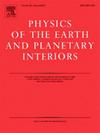Radial structure of the Earth: (I) Model concepts and data
IF 1.9
3区 地球科学
Q2 GEOCHEMISTRY & GEOPHYSICS
引用次数: 0
Abstract
A framework is introduced for developing a radial reference model that incorporates diverse observations and techniques for improving the constraints on bulk Earth structure. This study describes new modeling concepts and reference datasets while features of the reference Earth model REM1D and geological interpretations are discussed in a companion manuscript. Recent measurements from various techniques have improved in precision and are broadly consistent, and are summarized as best estimates with uncertainties. We construct a reference dataset comprising normal-mode eigenfrequencies and quality factors, surface-wave dispersion curves, impedance constraints and travel-time curves from body waves, and astronomic-geodetic observations. Classical radial reference models do not account for the theoretical effects and observational biases resulting from heterogeneity in the crust and mantle. We address three issues that account for lateral variations in the modeling of average elastic, anelastic and density structure. First, current ray coverage of traveling waves is biased towards structure in the northern hemisphere, leading to faster velocities especially in the lower mantle. Second, horizontal wavelength of the heterogeneity that a traveling wave encounters is assumed to be much greater than that of the corresponding normal mode in most ray-theoretical and finite-frequency formulations of wave propagation. Effects of the full volumetric sensitivity on local eigenfrequencies and phase velocities that are ignored with this approximation exceed the data uncertainty for both fundamental spheroidal (Rayleigh waves, T 220 s) and toroidal modes (Love waves, T 120 s); waves at these longer periods cannot be modeled solely in terms of radial variations along the ray path. Third, non-linear effects from the strongly heterogeneous crustal structure are substantial for shorter-period waves (T 100 s) and need to be accounted for while deriving radial models. After accounting for these issues on heterogeneity, rapid convergence for average structure is facilitated by utilizing a priori constraints from recent literature, analytical sensitivity kernels that account for physical dispersion, and a flexible parameterization comprising polynomial functions and cubic B-splines. By adopting a higher order polynomial for density than the elastic structure, artifacts that imply strong inhomogeneity and non-adiabaticity are avoided in potentially well-mixed regions like the outer core. Derivative properties like the gradient of bulk modulus with pressure ( = ) and the Bullen's stratification parameter are adjusted in the core to match expectations from mineral physics without deteriorating the fits to reference datasets. A cubic polynomial parameterization in the lower mantle is adequate to capture possible changes in the gradients of the modulus ratio associated with spin transitions in iron-bearing minerals. Radial reference models need to account for lateral heterogeneity and prior geological information in their construction to accurately represent the bulk average properties of a heterogeneous Earth.

地球的径向结构:(1)模型概念和数据
介绍了一个框架,用于开发一个径向参考模型,该模型结合了各种观测和技术,以改善对大块地球结构的约束。本研究描述了新的建模概念和参考数据集,而参考地球模型REM1D的特征和地质解释在一份配套手稿中进行了讨论。最近采用各种技术进行的测量在精度上有了提高,并且大体上是一致的,并被总结为具有不确定性的最佳估计。我们构建了一个参考数据集,包括正模特征频率和质量因子、表面波色散曲线、阻抗约束和体波旅行时间曲线以及天文大地观测数据。经典的径向参考模型没有考虑到由地壳和地幔的非均质性引起的理论影响和观测偏差。我们解决了三个问题,说明横向变化在平均弹性,非弹性和密度结构的建模。首先,当前行波的射线覆盖偏向于北半球的结构,导致速度更快,特别是在下地幔。其次,在大多数射线理论和有限频率的波传播公式中,行波遇到的非均匀性的水平波长被假设为远远大于相应的正常模式。这种近似忽略的全体积灵敏度对局部特征频率和相速度的影响超过了基本球面(瑞利波,时间≥220秒)和环面模式(洛夫波,时间≥120秒)的数据不确定性;这些较长周期的波不能仅仅根据沿射线路径的径向变化来模拟。第三,对于较短周期波(T≤100 s),强烈非均质地壳结构的非线性影响是重要的,在推导径向模型时需要考虑这些影响。在考虑了这些异质性问题之后,利用最近文献中的先验约束、考虑物理色散的分析灵敏度核以及由多项式函数和三次b样条组成的灵活参数化,可以促进平均结构的快速收敛。通过采用比弹性结构更高阶的密度多项式,在潜在的混合良好的区域(如外核)中避免了暗示强非均匀性和非绝热性的伪像。在岩心中调整了体积模量随压力的梯度(κ′= dκ/dp)和布伦分层参数ηB等导数性质,以匹配矿物物理的期望,而不会影响对参考数据集的拟合。下地幔的三次多项式参数化足以捕捉与含铁矿物自旋转变有关的模量比μ/κ梯度的可能变化。径向参考模型需要考虑横向非均质性和先前的地质信息,才能准确地表示非均质地球的总体平均性质。
本文章由计算机程序翻译,如有差异,请以英文原文为准。
求助全文
约1分钟内获得全文
求助全文
来源期刊

Physics of the Earth and Planetary Interiors
地学天文-地球化学与地球物理
CiteScore
5.00
自引率
4.30%
发文量
78
审稿时长
18.5 weeks
期刊介绍:
Launched in 1968 to fill the need for an international journal in the field of planetary physics, geodesy and geophysics, Physics of the Earth and Planetary Interiors has now grown to become important reading matter for all geophysicists. It is the only journal to be entirely devoted to the physical and chemical processes of planetary interiors.
Original research papers, review articles, short communications and book reviews are all published on a regular basis; and from time to time special issues of the journal are devoted to the publication of the proceedings of symposia and congresses which the editors feel will be of particular interest to the reader.
 求助内容:
求助内容: 应助结果提醒方式:
应助结果提醒方式:


